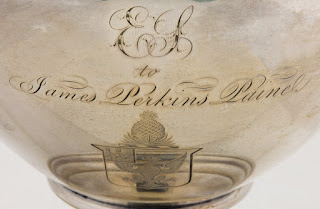 |
| Fig. 1. Harris, Stanwood & Co. (American, active 1839-1848). Covered Pitcher, about 1839-1848. Silver. Gift of the Paine Charitable Trust, 1965.326. |
Until May 2019, the silver object was given another attribution. While viewing WAM’s decorative arts online, I noticed it was cataloged as a chocolate pot, made circa 1820-1830 by “Ferris & Starr.” Unable to find any silversmith firms or jewelers with that name, I decided to investigate the object and its history more closely.
I recalled learning about chocolate pots while taking a graduate course on the decorative arts of dining at George Washington University. Most 17th- and 18th-century examples were made of silver or porcelain, two valuable materials that associated chocolate—made of cacao beans, an exotic import from Mesoamerica— with Western luxury.
These vessels contain a lid and hinged finial, with a small opening to accommodate a molinet, the utensil used to stir the liquid chocolate. Silver chocolate pots typically include a thick wooden handle to withstand heat; indeed, one could say chocolate pots were “hot” commodities! However, this object didn’t seem to possess any of these characteristics. Thus, I pulled it from storage to view it in person, hopeful that my questions would be answered and theories validated. As a result, I found a maker’s mark hidden underneath the base, stamped “Harris & Stanwood, Pure Coin Silver, Boston.” (Fig. 2)
 |
| Fig. 2. Detail of mark underneath pitcher's base. |
First appearing in the 1839 Boston directory, Harris, Stanwood & Co. was one of Boston’s distinguished jewelry houses and silver manufacturers in the early 19th century. (Figs. 3-4) Its founders William Harris and Henry B. Stanwood retailed a variety of goods at low prices, including: “Silver and Plated Wares, Watches, Clocks, Lamps, Gas Fixtures, Candelabras, Tea Trays, Fine Table Cutlery, Rich Fancy Goods, & Watches and Clocks cleaned and repaired by an experienced workman.”¹ The firm even experimented with types of oil in solar argand lamps.²
 |
| Fig. 4. Advertisement from the Boston Courier (January 7, 1839). |
When Harris retired in 1848, the firm changed hands and eventually reorganized to become the familiar Shreve, Crump & Low establishment. After finding examples of Harris & Stanwood silver at other New England institutions, I contacted Patricia Kane, the curator of American decorative arts at Yale University Art Gallery, to determine the object’s true identity. She confirmed my suspicions: it wasn’t a chocolate pot, but actually a covered pitcher!
More questions arose since reattributing this object. For instance, according to Kane, pitchers from 1800-1850 were made with and without covers. So, why do some have covers? One theory is that this Harris & Stanwood pitcher would have held water, wine, or beer—like flagons in church communion services.
On the other hand, it may have possessed a commemorative purpose as a presentation object. In December 1840, Harris and Stanwood created a pitcher for the Massachusetts Horticultural Society, to be awarded to its president Elijah Vose. One newspaper described it as “a specimen of exquisite workmanship…embellished with grapes, vines, and other appropriate emblems, beautifully chased, and highly finished.”³ However, the lack of chased decoration in this pitcher indicates its use as a container for liquid beverages, though it probably decorated the table.
Additional research is ongoing regarding the pitcher’s owner, whose identity is hinted by the engraved coat of arms and inscription “E S to James Perkins Paine.” (Fig. 5) Based on my initial findings, James Perkins Paine (1827-1910) was the descendant of Russell Sturgis and William Paine, whose silver service by Paul Revere is displayed at WAM. If he is related to Worcester’s Paine family, then the “E S” likely refers to Elizabeth “Betsy” Perkins Sturgis (1756-1843), his aunt who lived in Boston—and quite possibly near Harris and Stanwood’s firm!
 |
| Fig. 5. Detail of engraved inscription and coat of arms. |
My investigation into the Harris & Stanwood pitcher demonstrates how there are still mysteries to be solved, and stories to be unveiled at the Worcester Art Museum. Our decorative arts, in particular, need extensive research, analysis, and cataloging. About 2,664 objects encompass WAM’s American decorative arts collection, yet many remain in storage or lack a complete provenance or other valuable information.
This illustrates the fact that before the 20th century, art historians considered the decorative arts secondary to fine art paintings and sculpture. While WAM’s former American curator Louis Dresser significantly acquired and researched Paul Revere silver during the 1960s, her successors made little efforts to showcase the decorative arts. By placing objects first, museums can tell the full story of a period, culture, and community.
Beginning Fall 2021, WAM will integrate the fine and decorative arts in its American galleries, a project funded by the Henry Luce Foundation (titled Conspicuous Consumption: The Price of Luxury in Early America). In doing so, I hope visitors can learn and appreciate the intrinsic value of early American objects like this covered pitcher.
—By Elizabeth Fox, Curatorial Assistant of American Art
June 30, 2020
------------------------------------------------------------
1 1847-8 Adams’s Boston Directory
2 Referenced in "To the Public," Atlas (Boston, Massachusetts), December 15, 1842. Harris and Stanwood inspected numerous whale oils, rating them based on cost and ability to produce artificial light.
3 National Aegis (Worcester, Massachusetts), December 30, 1840.






